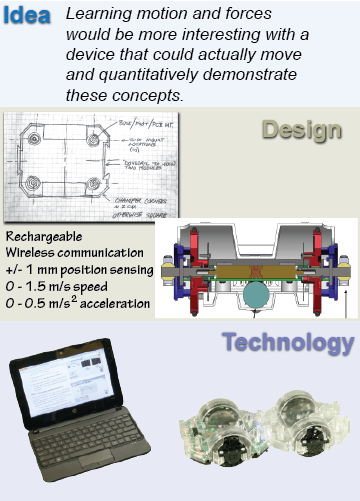|
Engineering is the application of science to design products or inventions that meet human needs. Engineering is very creative. A remarkable new product, such as a cellphone, has to be created in the mind of the engineer before it can be built of metal and plastic. Engineers invent technology that could make the future cleaner, safer, healthier, and more productive. Engineering also has a dark side because weapons are created by engineers, and some technologies have harmful side effects. 
| 
|
It is in our common human interest for everyone to understand the basic engineering design principles and trade-offs inherent in all technologies. This book features many case studies that show you how aspects of physics directly affect the design of technology. 
 |
In school it may seem like the purpose of learning physics is to solve problems in a book or on a test. In practice that is not true. Science is most often applied to do engineering. The basic knowledge of physics may be directly applied to designing cars (mechanical engineering) or bridges (civil engineering) or computer circuits (electrical engineering). Knowledge of chemistry might be applied to creating new materials (materials engineering) or fuels (chemical engineering) or medicines (biomedical engineering). These are just a few examples of the breadth of engineering. Much of your living environment was created by engineers. Today, even things that grow and are part of the planet may have been engineered. 
|
An engineering problem typically involves designing a device that must perform a function. The design has constraints such as cost, energy consumption, reliability, or longevity. Engineering problems are fundamentally different from textbook problems because there is no single right answer. There may be many designs that achieve the goals. For example, more than a dozen different kinds of wind turbines are being tried as alternative energy sources. Different designs may best fit different constraints. 
|

|
The engineering method typically starts with a design concept. Complicated goals are broken down into smaller goals that can each be solved with a subsystem. The design is made real with a prototype, a functional model that can be used to test and see how well things work. The results of tests are used to revise the design and make it better. The cycle of prototype–test–evaluate–revise is repeated many times before the final product is ready. Often the final product looks nothing like the initial concept! Much like the scientific method, the engineering method is a process of envisioning, testing, and improving a design until, after many iterations, it best solves the initial problem. 
 |
The engineering method above is just one way to describe the engineering process. Another version, called “engineering is elementary,” breaks down the process into a similar set of steps: - Ask: What are the problem and the design constraints?
- Imagine: Think of some solutions and brainstorm others with your peers.
- Plan: Create a design or diagram, and draw up a list of needed materials.
- Create: Construct the prototype of your design and test it out.
- Change: Evaluate the performance of your design and think of ways to modify it to improve its performance. Test out your new design.

|
Manufacturing is the production of goods using methods such as labor, tools, and machines. Many careers in engineering focus on improving manufacturing processes. 
 |
Two broad categories of manufacturing processes are called additive and subtractive. Machine tooling is a subtractive manufacturing process, because machines will typically cut away excess material (such as metal) from the raw material to create a part. A machinist may use hand tools or larger machines, such as milling, drilling, turning, and grinding machines. An additive manufacturing process will deposit material, usually in successive layers, to construct a part. The 3-D printer and stereolithography are examples of additive processes. 
|
Which of the following technologies were invented through the engineering design cycle? - water pump
- spinning wheel
- light bulb
- race car
- all of the above
 |
All of these technologies are a result of engineering. Although the development of technology in ancient times was not strictly referred to as “engineering,” the technologies were developed in response to specific problems in the world.
The light bulb is a famous example of the engineering design cycle. Many iterations were attempted by many inventors before Tomas Edison invented a practical electric light bulb. Like all these technologies, the light bulb is continuously being refined and re-engineered even today. 
|

